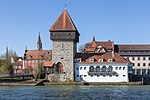University of Konstanz

The University of Konstanz (German: Universität Konstanz) is a university in the city of Konstanz in Baden-Württemberg, Germany. Its main campus was opened on the Gießberg in 1972 after being founded in 1966. The university is Germany's southernmost university and is situated on the shore of Lake Constance just four kilometres from the Swiss border. It has been successful in all three funding lines of the Excellence Initiative, and is therefore one of Germany's elite "Universities of Excellence", a group of prestigious universities often considered the German Ivy League. The university is ranked in top 100 worldwide in the field of social policy and administration in the 2020 QS World University Rankings, and ranked 51 in Political Science according to the 2020 ShanghaiRanking. The U.S. Department of Energy also refers to the University of Konstanz as a "small Harvard".Moreover, the University of Konstanz cooperates with a large number of renowned institutions, such as Harvard, Johns Hopkins University, Yale University, the University of Chicago, UC Berkeley, University of Zurich, and the Balsillie School of International Affairs.In addition to having approximately 11,500 students from around 100 countries, the university maintains over 220 partnerships with European universities as well as numerous international exchange programmes, thereby facilitating global networking. Students may choose from more than 100 degree programmes. Its library is open 24 hours a day and has more than two million books.
Excerpt from the Wikipedia article University of Konstanz (License: CC BY-SA 3.0, Authors, Images).University of Konstanz
Universitätsstraße, Verwaltungsgemeinschaft Konstanz
Geographical coordinates (GPS) Address External links Nearby Places Show on map
Geographical coordinates (GPS)
| Latitude | Longitude |
|---|---|
| N 47.69 ° | E 9.188 ° |
Address
Universität Konstanz
Universitätsstraße 10
78464 Verwaltungsgemeinschaft Konstanz, Konstanz-Egg
Baden-Württemberg, Germany
Open on Google Maps









